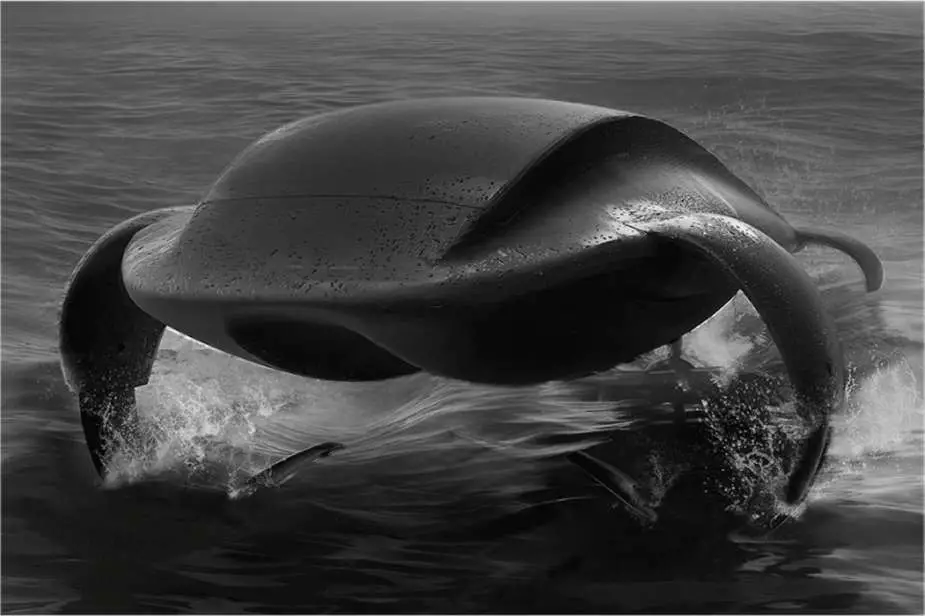Breaking news
Kraken K40 Manta USSV to achieve full autonomy with L3Harris.
On November 1, 2023, Kraken Technology Group (KTG) announced a collaboration with L3Harris Technologies to advance the integration of control systems within the K40 Manta uncrewed surface-subsurface (USSV) prototype. This collaboration lays the foundation for the development of enhanced autonomous capabilities, with the goal of achieving full autonomy for this USSV.
Follow Navy Recognition on Google News at this link
 The Kraken K40 MANTA is an uncrewed surface-subsurface (USSV) platform that employs foils for rapid surface transit before submerging for covert maneuvers (Picture source: KTG)
The Kraken K40 MANTA is an uncrewed surface-subsurface (USSV) platform that employs foils for rapid surface transit before submerging for covert maneuvers (Picture source: KTG)
The K40 is an uncrewed surface-subsurface (USSV) platform that employs foils for rapid surface transit before submerging for covert maneuvers. This high-performance vessel necessitates advanced control systems, and L3Harris possesses the expertise and components required for the seamless integration of these systems into the K40 Manta. These integrated systems will facilitate remote control of the uncrewed platform for engineering testing, foil development, powertrain calibration, and demonstrations during the initial stages of development.
Mal Crease, founder and CEO of Kraken Technology Group, expressed anticipation for the collaboration as a foundation for future developments. Similarly, Mark Exeter, Managing Director of ASV at L3Harris, highlighted the complementary skills of both companies and the potential for broader cooperation, given their proximity to Portsmouth, a recognized UK marine innovation hub.
The K40 Manta is an uncrewed surface-subsurface (USSV) platform designed for rapid uncrewed surface transit of sensor or strike payloads over considerable distances, followed by submergence for covert operations, persistent reconnaissance, or loitering missions. It features a high-performance foiling carbon structure, flexibility for multi-mission roles, electronic warfare functions, strike capabilities, extended-duration loitering or sleeper modes, and a payload bay for modular configurations of up to 1,000kg. The vessel supports up to 10 days of autonomous operations and offers ease of stowage, launch, and recovery from various vessels.
The K40 Manta is equipped with advanced systems for autonomous operation, open interfaces to autonomy, and a modular, payload-agnostic design, accommodating UAV loitering sensors and munitions, ISTAR data collection and distribution, electro-optical and signals intelligence capabilities, seabed sensors, sonobuoys, and is deployable in ISO containers and C-130 aircraft.
The construction of the K40 Manta includes an advanced composite structure and a foiling design that minimizes visual, acoustic, radar, and thermal signatures. It also features a deployable sensor mast for enhanced functionality.
The K40 Manta comes in various size configurations, each tailored to specific mission requirements. The Manta 54 has a length overall of 16.5 m, with a maximum speed of 60 knots on the surface and 10 knots when submerged, a range of 1000 nautical miles, and a hybrid electric powertrain, capable of carrying a payload of 5,000 kg.
The Manta 36 offers a more compact design with an overall length of 11 m. It can reach speeds of up to 45 knots on the surface and 10 knots submerged, with a range of 300 nautical miles. This variant is powered by an electric powertrain and can carry a payload of 1,500 kg.
For even more flexibility, the Manta 18 has a length overall of 5.5 m and a top speed of 30 knots on the surface, 10 knots submerged, and a range of 300 nautical miles. It is also powered by an electric powertrain and can carry a 100 kg payload.
The smallest in the series, the Manta 12, measures 3.7 m in length and can reach speeds of 30 knots on the surface, and 10 knots when submerged. It has a range of 300 nautical miles and is equipped with an electric powertrain, capable of carrying a 25 kg payload.























